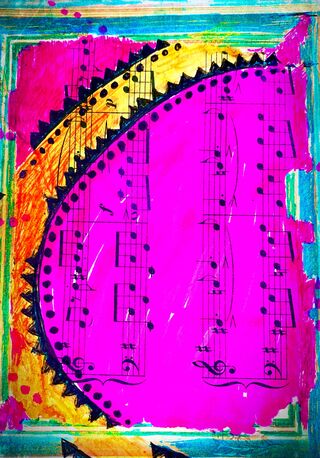
“I Simply Maintain Shedding My Beat,” from the visible journals of Cathy Malchiodi, Ph.D.
Supply: © 2017 Courtesy of Cathy Malchiodi, Ph.D.
Are rhythm-based experiences useful for individuals with traumatic stress? Some have steered that it’s one strategy to bypass cognitive functioning and assist connections by way of extra primitive components of the mind impacted by trauma (Perry, 2009). In different phrases, interventions that concentrate on a sensory-based stage may very well be more practical than purely cognitive methods. Present considering tells us that rhythm stimulates patterned and repetitive experiences and influences thoughts and physique in wide-reaching methods. Relying on the beat, rhythmic experiences can energize, result in sensations of enlivenment, or interact us by means of entrainment and synchrony. When trauma has dulled the power to expertise pleasure, playfulness, and pleasure, rhythm could be a strategy to reintroduce aliveness to physique and thoughts (Malchiodi, 2020).
Technically, by definition rhythm is the size of notes. Tempo is one other vital time period; it really refers back to the tempo of a bit of music and the way shortly or slowly it goes by. There’s additionally meter—how onerous or gentle you faucet your foot or clap your fingers, for instance, when listening to music. So. if you find yourself tapping or clapping to music, there are some beats that appear stronger than others when grouped collectively. All three of those parts are sometimes implied within the expertise of rhythm although every has a barely completely different which means. For simplicity’s sake, simply consider rhythm because the overarching idea in terms of making use of it in expressive arts and trauma therapy. It’s typically best to consider it as the way you or your shopper perceives the “heartbeat” or pulse of any rhythm, sound, or music.
Everybody reacts otherwise to music; we reply to cadence, melody, and lyrics relying on our experiences and different elements. In working with people of all ages who’ve traumatic stress there are private preferences for rhythms (quick, gradual, loud, smooth) alongside an intensive continuum. In working with traumatized kids over a long time, I noticed that their engagement with percussion typically emerges in extremes. That’s, typically a baby with traumatic stress used devices very loudly or very softly and really quick or very gradual [or not at all after initial attempts]. One other would possibly sing in monotone or in a slim vary of rhythms, typically getting caught in repetition with out flexibility. I realized that serving to these kids and later, adults perceive alternative ways to expertise rhythm started to assist the pliability essential to self-regulate their struggles with hyperactivation. In different circumstances, rhythm turned the place to begin to re-sensitize kids and adults to experiences of play, power, and enlivenment that years of traumatic stress and hostile occasions robbed from them.
There are various methods to introduce rhythm into psychotherapy together with combos of motion, gesture, image-making, and vocalization. However drums and percussion devices are presumably essentially the most extensively used as a result of they’re accessible types of “rhythm communication” for kids and adults. Listed below are 4 features of expressive arts in addressing traumatic stress which can be significantly related when introducing rhythm as a reparative and restorative expertise with a give attention to music and sound:
1. Self-Regulation. Essentially the most fundamental operate of rhythm is present in physiological regulation. In different phrases, rhythm is a supply of stabilization that helps an internalized sense of security. For a lot of people at first levels of trauma therapy, targeted music listening and soothing sounds or taking part in devices with calming tones akin to a tongue or “Panda” drum are a part of reducing hyperactivation. Equally, when withdrawal or dissociation are outstanding reactions, rhythm-based experiences may also help the person safely discover what enlivens or energizes, grounding and anchoring the particular person within the “right here and now.”
2. Co-Regulation. When making sounds, vocalizations, or music collectively, entrainment and synchrony grow to be core parts of rhythmic experiences. In expressive arts remedy classes, this takes place between the therapist and particular person; in a bunch, this will embrace drumming collectively, sharing singing, or structured expressive arts designed to assist co-regulation. Whereas physiological regulation is the primary objective, constructive attachment and cohesive relationships are additionally bolstered.
3. Exploration. Rhythm-based experiences are the inspiration of improvisational actions that result in eventual expression of feelings and ideas. For instance, drumming sounds to precise feelings is a type of implicit, sensory-based communication that stimulates narrative (cognitive) explanations in psychotherapeutic classes. Exploratory rhythm actions additionally could be a foundation for deepening arts-based expression that result in songwriting, an integrative expertise.
4. Restoration. In expressive arts remedy, my objective as a psychotherapist is to finally facilitate restoration of the self. That’s, to see the person, household, or group recuperate wholeness by means of a way of well-being, resilience-building, and social engagement. In her three-part trauma restoration mannequin, Herman (1992) cited the vital step of re-entering neighborhood—the integrative course of for the personal and public self. Whereas among the restorative course of is supported in psychotherapy classes, the “rhythm of restoration” typically features a wider viewers by means of efficiency of what one creates. In different phrases, this operate will not be restricted to psychotherapy, however typically contains friends, assist teams, neighborhood arts programming, and different neighborhood contexts the place arts-based expressions akin to songs and efficiency are shared.
Whereas rhythm-based experiences could affect mind exercise in terms of trauma, there may be really a continuum of reparation we are able to look to when working with expressive approaches. Though regulatory properties of rhythm may be physiological pathways to each soothing and enlivening the physique, finally restoration is discovered within the “social rhythm” of expressive arts remedy and the way these rhythms join us in therapeutic and health-giving methods.
To discover a therapist, please go to the Psychology Today Therapy Directory.
Source link













